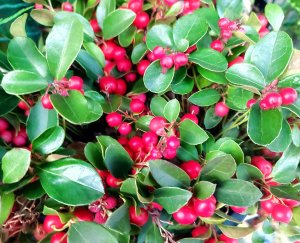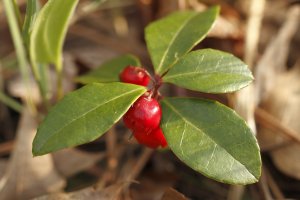Wild Wednesday: American Wintergreen
December 14, 2022
By: Kaitlyn Burkey, Interpreter
Candy canes, peppermint hot chocolate, and other minty treats start to appear everywhere in the winter months on menus and in grocery store aisles. Originally, one of the ways that the flavor of mint was added to foods and beverages, was from the oils of a common native Michigan plant: American Wintergreen!
Wintergreen (Gaultheria procumbens) is a woody evergreen groundcover plant found in nearly every county in Michigan and throughout much of the eastern US and Canada. It tolerates sun, shade, and everything in between, and its low, spreading habit along with the four-season color of the leaves and fruits make it a great fit for a low-maintenance, high-wildlife-value backyard ground cover.

Wintergreen is in the blueberry family and usually grows in moist, acidic soil in the understory of hardwood forests. The leaves are oblong shaped and leathery. When crushed between your fingers, the leaves give off a pleasant minty aroma. White bell-shaped flowers form in early summer, which then become bright red berries. The berries can be found throughout winter and provide an excellent source of food for many of the animals in the forest. Wintergreen is also considered an evergreen, as those leathery leaves linger year-round, making it one of the few spots of color on the forest understory during our snowy Michigan winters.

Wintergreen is also known as Eastern Teaberry. It was used to flavor teas and oils. Along with a source of mint flavor, the oil from wintergreen was once used as an anti-inflammatory medicine.
The landscape of Michigan in winter can seem dull and lifeless but these small evergreen shrubs breathe life into the forest with their vibrant green and red among the often bare and brown forests.
